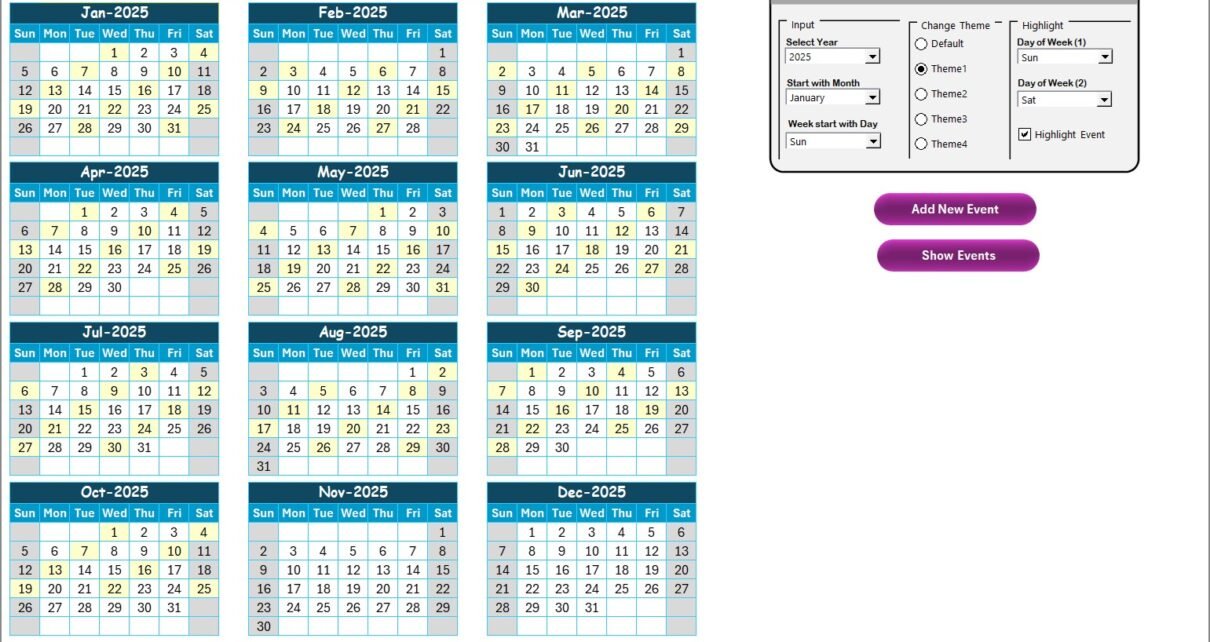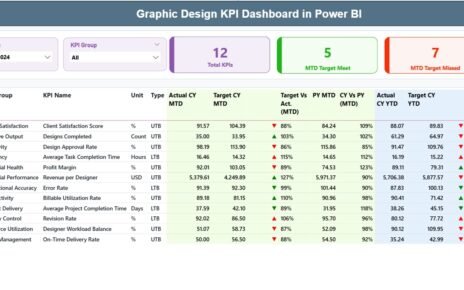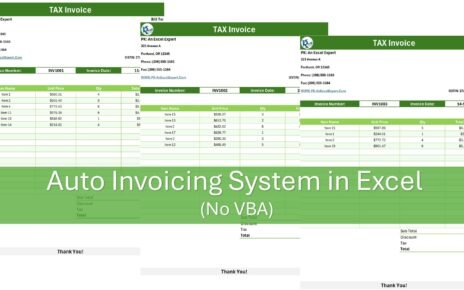In today’s world, financial departments face continuous challenges in maintaining accuracy, compliance, and efficiency.Finance Quality Control AI Implementation Calendar in Excel From tracking audits and reconciliations to monitoring reporting deadlines and control checks — finance teams need a structured way to plan and manage activities. That’s where the Finance Quality Control AI Implementation Calendar in Excel comes in.
Finance Quality Control AI Implementation Calendar in Excel This ready-to-use Excel-based calendar integrates intelligent automation and smart event management to help finance professionals streamline their daily, monthly, and annual quality control operations with precision and ease.
Click to Purchases Finance Quality Control AI Implementation Calendar in Excel
What Is the Finance Quality Control AI Implementation Calendar in Excel?
The Finance Quality Control AI Implementation Calendar in Excel is a smart digital planner designed to organize, track, and manage financial quality control tasks across the year. Built using Excel, it eliminates the need for manual tracking and enables seamless automation for planning AI-driven financial control initiatives.
It’s not just a calendar — it’s a comprehensive management system that gives finance teams full visibility into their audit activities, process improvements, AI integration schedules, and event planning.
Click to Purchases Finance Quality Control AI Implementation Calendar in Excel
This tool is ideal for:
-
Finance managers implementing AI for quality control.
-
Internal audit and compliance teams.
-
CFO offices planning annual quality control initiatives.
-
Project managers leading AI transformation in finance.
Key Features of the Calendar Template
The template is divided into five interactive worksheet tabs, each designed for a specific purpose. Let’s explore each tab in detail.
1. Home Sheet Tab – The Central Control Hub
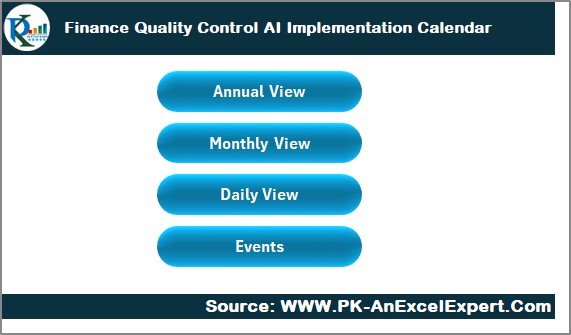
The Home Sheet serves as the index or dashboard of the workbook. It provides quick access to every key section of the calendar through interactive buttons.
You’ll find four main navigation buttons:
-
🟢 Annual View
-
🔵 Monthly View
-
🟣 Daily View
-
🟠 Events
With a single click, you can jump to any section — saving time and reducing manual scrolling. This makes navigation smooth and user-friendly, especially for professionals handling multiple projects or audits simultaneously.
The home page creates a clean, professional impression — setting the tone for organized financial management.
2. Annual View Sheet Tab – Yearly Planning at a Glance
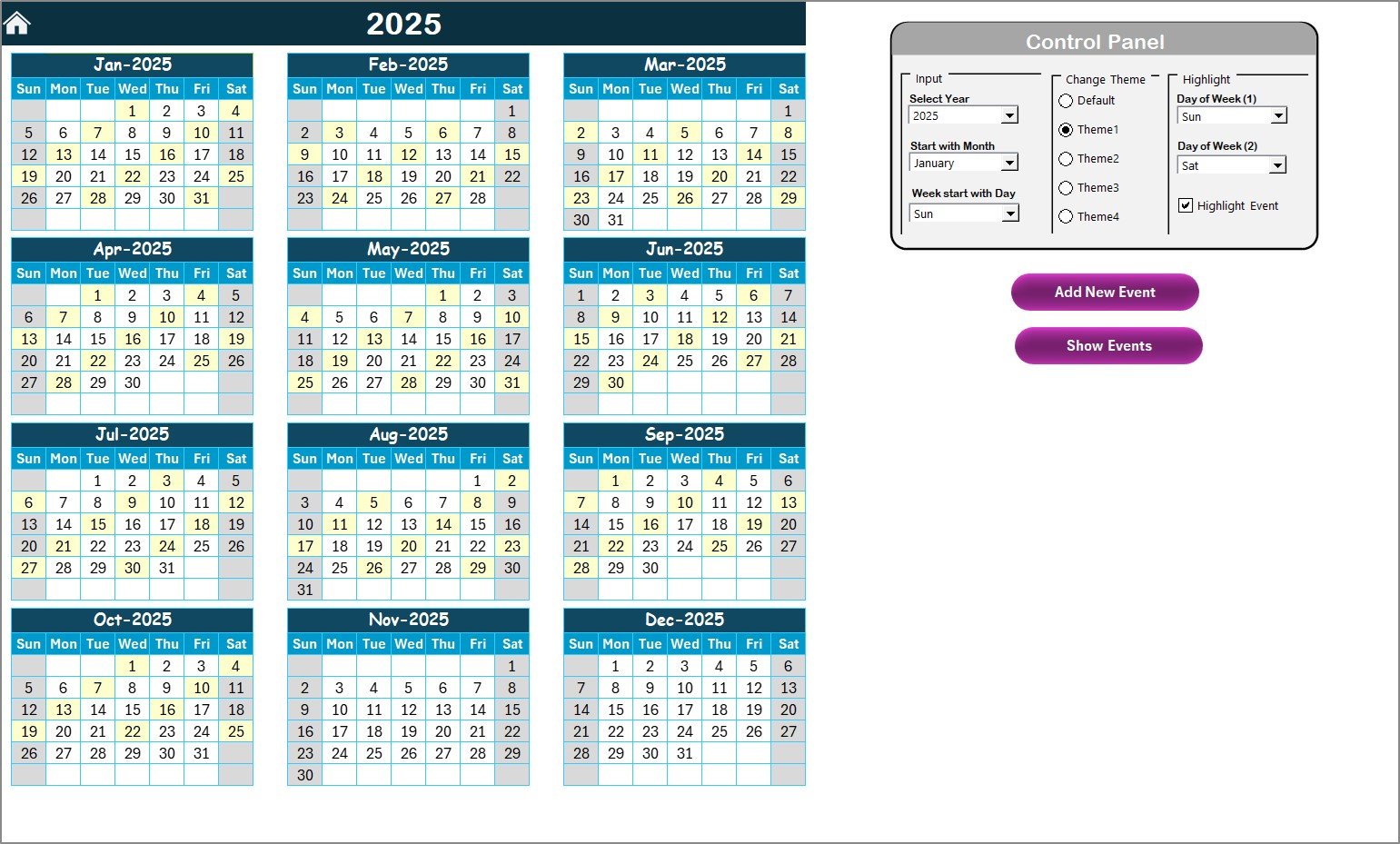
The Annual View Sheet provides a 12-month overview of all financial activities and AI implementation milestones. It helps management visualize the entire year’s tasks, from audit deadlines to automation rollouts.
🧭 Control Panel Overview
At the top, the Control Panel allows users to customize the calendar in just a few clicks. It includes three main groups:
-
Input Group:
-
Select the Year to auto-update the full annual calendar.
-
Choose the Starting Month for flexibility in fiscal year alignment.
-
Pick the Starting Day of the Week (e.g., Monday or Sunday).
-
-
Change Theme Group:
-
Choose from five color themes to match your department or company’s branding.
-
Change the appearance of the entire workbook with one selection.
-
-
Highlight Group:
-
Highlight specific days (e.g., Saturday and Sunday) in grey for weekends.
-
Use the Highlight Event checkbox to mark special events in yellow.
-
These features make the annual calendar both informative and visually appealing — a perfect blend of function and design.
🟢 Add New Event Button
Click this button, select any date, and open the Add Event Form.
You can enter:
-
Event Name
-
Time
-
Location
-
Description
After submitting, the event automatically appears on the selected date in the calendar.
🔵 Show Event Button
Select a date and click Show Event to view all planned activities for that day — from financial audits to AI training sessions.
This setup turns the annual sheet into a real-time financial planning dashboard.
3. Monthly View Sheet Tab – Track Monthly Activities Efficiently
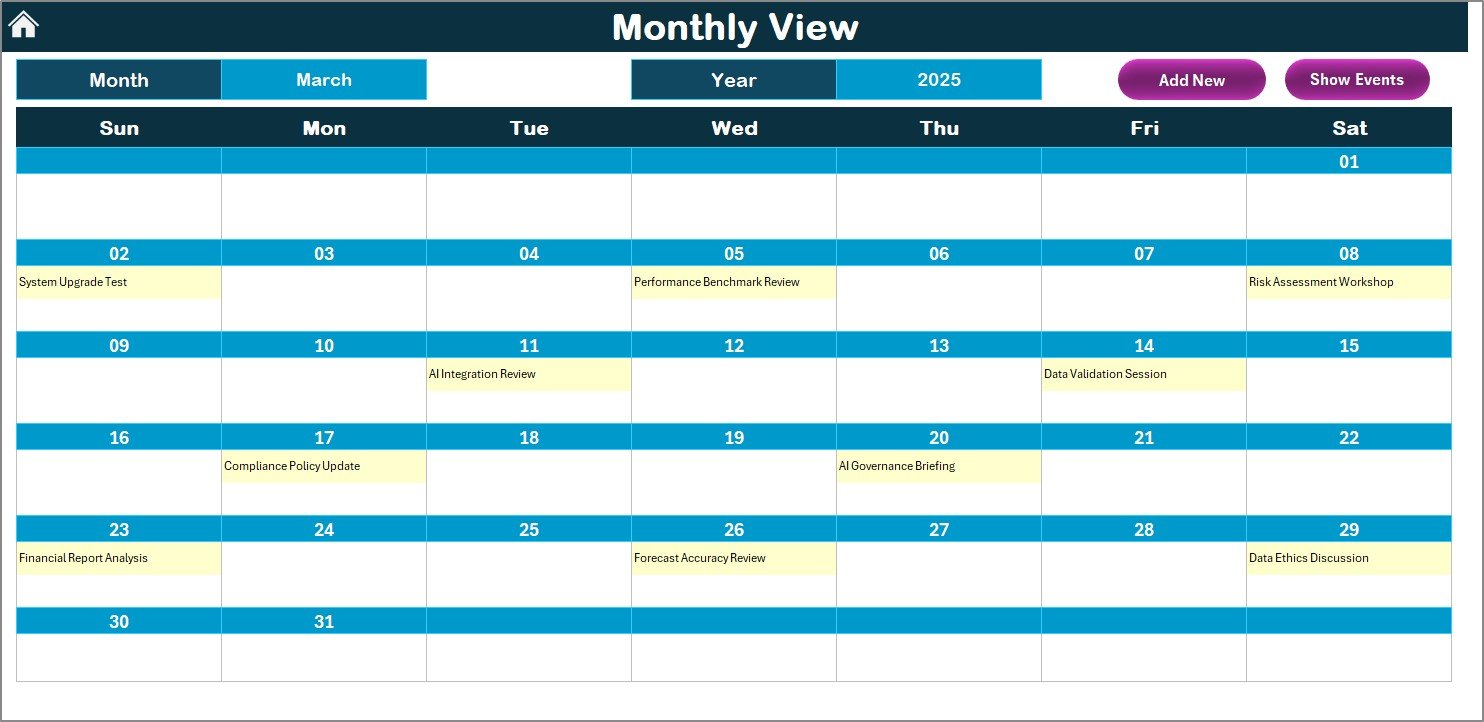
The Monthly View Sheet focuses on one month at a time, allowing users to analyze tasks, AI rollout phases, or control checks in detail.
You can select the Month and Year from dropdown menus, and the calendar instantly adjusts.
If multiple events exist on a particular date, the cell displays “more than 1…” to indicate additional activities.
🧩 Top Buttons
-
Add New Event: Quickly insert a new task or meeting into the monthly calendar.
-
Show Event: Instantly display all scheduled events for a chosen date.
This monthly view helps finance teams plan operational tasks like:
-
Invoice verification timelines
-
Audit review schedules
-
System control testing
-
AI model validation sessions
-
Internal compliance reviews
It’s the perfect middle ground between the big-picture annual view and the detailed daily analysis.
4. Daily View Sheet Tab – Focused Day-to-Day Management

The Daily View Sheet gives a complete overview of events within a specific date range.
You can select:
-
Start Date and End Date using the calendar icons.
-
Click Refresh to display updated data instantly.
Every event between those dates appears in a detailed table, including:
-
Date
-
Event Name
-
Time
-
Location
-
Description
The Add New Event Button on this sheet enables quick addition of new daily records through a simple form.
This feature helps finance departments keep track of high-priority daily tasks, such as:
-
Audit follow-ups
-
Quality control checkpoints
-
AI testing milestones
-
Financial closure updates
5. Events Sheet Tab – Centralized Data Repository
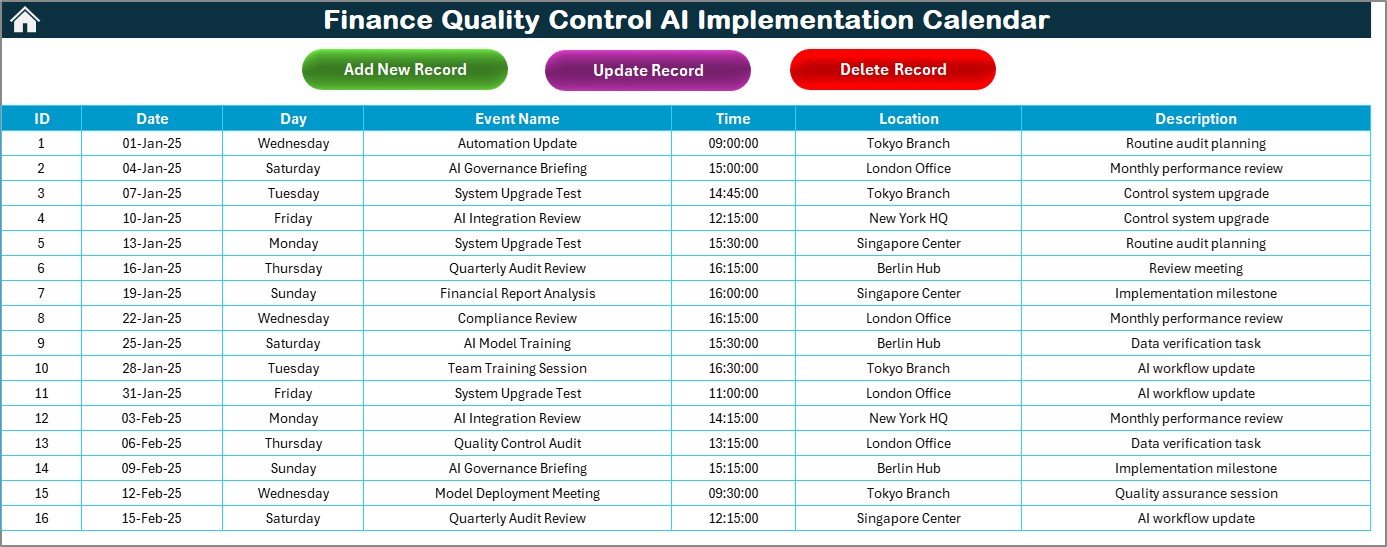
The Events Sheet acts as the database where all entries from Annual, Monthly, and Daily views are stored automatically.
Each event record includes:
-
ID: Auto-generated for unique identification.
-
Date: The scheduled day of the event.
-
Day: The day of the week (Monday–Sunday).
-
Event Name: The activity or task name.
-
Time: Event time slot.
-
Location: Meeting or event venue.
-
Description: Short event details.
🧠 Event Management Buttons
-
Add New Record: Opens a data entry form for creating a new event.
-
Update Existing Record: Allows editing of previously added events.
-
Delete Record: Removes unnecessary or outdated entries.
This structured event database supports seamless data management while ensuring that all activities remain traceable and auditable.
Click to Purchases Finance Quality Control AI Implementation Calendar in Excel
Why Choose Excel for AI Implementation Planning in Finance?
Many organizations still rely on Excel because of its:
-
Accessibility
-
Compatibility
-
Customization
-
Data security
The Finance Quality Control AI Implementation Calendar leverages Excel’s power to combine flexibility with automation.
Users can run macros, implement data validation, and integrate it with other systems such as Power BI or SharePoint for enterprise-wide reporting.
Moreover, Excel makes collaboration simple — finance professionals can share files via OneDrive or Google Drive, enabling synchronized access across the team.
Advantages of Finance Quality Control AI Implementation Calendar in Excel
Using this AI-enabled Excel calendar offers several benefits for finance professionals:
1. Centralized Financial Planning
All annual, monthly, and daily activities appear in one location. This makes it easy to monitor progress and ensure deadlines are met without confusion.
2. Enhanced AI Integration Management
Finance teams implementing AI-based controls (like anomaly detection or predictive reconciliation) can schedule their rollout steps efficiently.
3. Reduced Manual Work
Automated forms and event-tracking buttons eliminate repetitive data entry, saving time and minimizing human error.
4. Visual Insights
Color-coded highlights and themes improve readability and provide instant insights into weekends, events, and holidays.
5. Improved Accountability
Event IDs and detailed logs make it simple to audit actions and maintain compliance with corporate governance standards.
6. Easy Customization
Users can adapt the calendar to match fiscal years, internal workflows, or department-specific reporting cycles.
7. Cost-Effective Solution
Unlike complex project management tools, this Excel template offers professional functionality without any subscription fees.
How to Use the Finance Quality Control AI Implementation Calendar Effectively
To get the most out of this tool, follow these easy steps:
-
Start from the Home Sheet.
Use navigation buttons to move between sheets. -
Configure Your Annual View.
Select your desired year, theme, and highlight settings. -
Add Key Events.
Enter audit dates, report deadlines, AI review sessions, or compliance meetings. -
Monitor Monthly Progress.
Check pending or completed events in the Monthly View. -
Review Daily Tasks.
Focus on daily operational controls and automated testing events. -
Maintain the Events Database.
Regularly update or delete events to keep your records clean and relevant.
AI in Finance Quality Control – A Game Changer
Artificial Intelligence is transforming the way finance departments manage quality control.
When integrated with a structured Excel calendar, AI can automate several key processes:
-
Anomaly Detection: AI models can flag irregular financial transactions.
-
Reconciliation Automation: Systems match and verify transactions faster.
-
Forecasting: Predictive analytics identify potential control gaps.
-
Error Prevention: AI-based learning helps reduce reporting inaccuracies.
By scheduling AI implementation through the calendar, finance teams ensure a phased, organized, and measurable rollout.
Click to Purchases Finance Quality Control AI Implementation Calendar in Excel
Best Practices for the Finance Quality Control AI Implementation Calendar in Excel
To maximize the value of this calendar, follow these best practices:
-
Define Clear Categories:
Use consistent naming conventions for events (e.g., “Audit Check,” “System Validation,” “AI Training”). -
Use Color Coding Wisely:
Apply themes strategically to differentiate between control activities, training, and meetings. -
Review Data Monthly:
Regularly clean up the events list to maintain database accuracy. -
Leverage Automation:
Enable Excel macros to automate repetitive tasks such as adding or updating events. -
Ensure Data Backup:
Store copies in cloud storage for data recovery and collaboration. -
Track AI Milestones:
Schedule every AI integration step (e.g., testing, validation, deployment) for accountability. -
Encourage Team Usage:
Share the file with your team to promote transparency and better planning. -
Monitor Trends:
Use the Annual and Monthly Views to identify peak workloads and plan resources accordingly.
Practical Use Cases
Here are some real-world ways finance departments can use this calendar:
-
Audit Scheduling: Track all internal and external audits.
-
AI Implementation: Plan training sessions and rollout dates.
-
Risk Review: Schedule quarterly compliance and risk assessments.
-
Financial Closure Planning: Manage month-end and year-end activities.
-
Vendor Payments Control: Monitor deadlines for financial checks.
-
Reporting: Schedule and manage report submissions.
This flexibility makes it useful across organizations of all sizes — from small firms to large enterprises.
How AI Enhances Financial Quality Control
AI in finance isn’t just a trend — it’s a transformation. Here’s how it aligns perfectly with the calendar:
-
Predictive Accuracy: AI predicts anomalies before they occur.
-
Automation: Reduces manual verification and reconciliation.
-
Real-Time Insights: Ensures continuous monitoring of quality metrics.
-
Efficiency: Frees finance teams to focus on strategy rather than repetitive tasks.
When combined with a calendar that organizes events and rollouts, AI becomes a practical and measurable tool for financial improvement.
Conclusion
The Finance Quality Control AI Implementation Calendar in Excel is more than just a planner — it’s a complete management framework for finance teams embracing digital transformation.
By combining the flexibility of Excel with the intelligence of AI, this tool helps professionals plan, monitor, and execute financial quality control initiatives with unmatched precision.
Whether you’re managing audits, implementing new controls, or rolling out AI projects, this Excel template keeps everything structured and accessible.
It’s the perfect companion for modern finance departments aiming for excellence and compliance.
Click to Purchases Finance Quality Control AI Implementation Calendar in Excel
Frequently Asked Questions (FAQs)
1. Who can use the Finance Quality Control AI Implementation Calendar?
Finance managers, auditors, compliance officers, and data analysts can use it to manage quality control tasks and AI integration timelines.
2. Does it require advanced Excel knowledge?
No. The template is user-friendly. With simple buttons and dropdowns, anyone familiar with Excel can operate it easily.
3. Can I customize the color themes or control panel?
Yes. You can select from five color themes and adjust the calendar’s design through the built-in control panel.
4. How does the AI aspect fit into this Excel tool?
While the core template is Excel-based, it’s structured to support AI implementation schedules, data tracking, and integration timelines.
5. Can I track multiple financial control projects simultaneously?
Absolutely. The Events Sheet and filters allow managing multiple projects, departments, or audit types at once.
6. Is this template compatible with Google Sheets or Excel Online?
Yes. It works in both environments, although macros perform best in desktop Excel.
7. Can I print or export the annual or monthly calendars?
Yes. Each view is formatted for print and can be exported as a PDF for reporting or sharing.
8. How often should I update the calendar?
Ideally, update it weekly or after every major financial event to maintain data accuracy.
Click to Purchases Finance Quality Control AI Implementation Calendar in Excel
Visit our YouTube channel to learn step-by-step video tutorials
